"Unleash the Secrets to Perfect Leash Training: From Puppies to Polished Pooches!"
- Peter Bonney Director
- Aug 14, 2023
- 18 min read
Updated: Feb 14, 2024
Introduction:
Let's "Unleash the Secrets to Perfect Leash Training: From Puppies to Polished Pooches!"
Leash training is an essential skill for you the human, and both puppies and older dogs, ensuring a safe and enjoyable experience for you and your Best Mate. Whether you're starting with a young puppy or adopting an older pup or juvenile dog, understanding how to use a leash correctly is crucial for effective training and overall well-being. In this article, we'll cover the ins and outs of leash training, when to start, how to use a leash properly, and the right types of leads or leashes to use for different stages of your mates development. Of course knowing when to train on a leash and knowing "When is the Best time to begin Puppy Training" is equally important. So - Let's get on to unleash the secrets to perfect leash training.
What's the difference between a Leash and a Lead?
According to "Collins Dictionary" the meaning of a Leash is A dog's leash is a long thin piece of leather or a chain, which you attach to the dog's collar so that you can keep the dog under control. All dogs in public places should be on a leash.
A lead can be defined as “to cause (a person or animal) to go with one by holding them by the hand, a halter, a rope, etc., while moving forward.“
In this case we can see that People lead a dog using a leash. It really does not matter what we call it. In this article a lead is a leash, and a leash is a lead.
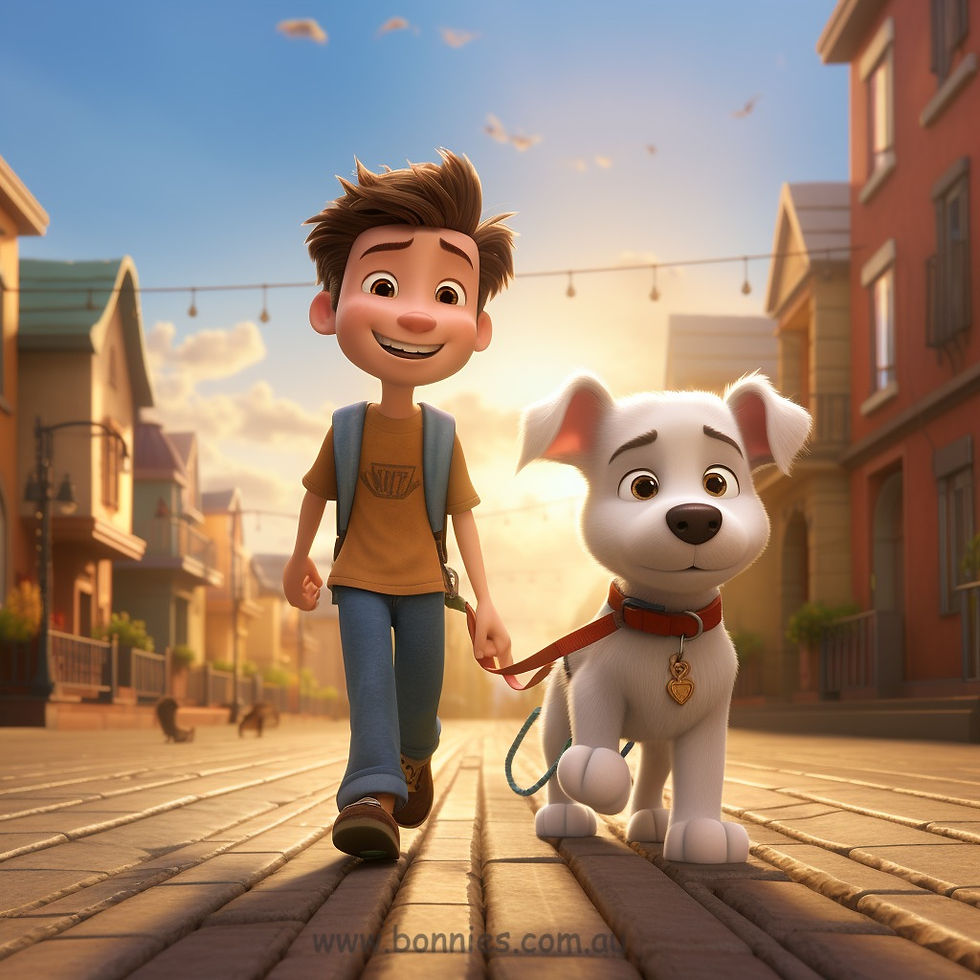
What is the best age to start using a Leash on a Puppy?
Getting your puppy accustomed to a leash, familiarised, is a crucial step that sets the foundation for a well-behaved Best Mate. Ideally, leash training should commence as early as 8 to 10 weeks old, instilling really positive behaviors and helping to prevent future possible issues. As an example of "What is the best time to start?" Breeders often use collars early in the life of the puppy to begin this foundation step, oh, and then they can identify "who's who in the Zoo"? However, it's not just about formal training – positive association and gradual familiarity are key. Start by allowing your puppy to wear a lightweight collar, correctly attached to a leash we call a house leash. Please make sure the collar is fitted correctly. "A man's Tie".
What exactly is a house leash?
Unlike traditional walking, training, or exercise leashes, a house leash lacks a loop or handle your hold, at the end of it, preventing it getting hooked on furniture. Using this house leash requires vigilant supervision as anything can and often does happen when the puppy is out and about. You probably can't buy one like this, so get an old leash, or an inexpensive one from a store, and cut the end off it removing the loop or hand grip. Please - fancy leash's are not needed for this. Basic and Flat will be fine. Please don't leave the "House Leash" on your puppy when in their crate or Playpen.
Why should you introduce a leash to your puppy?
It connects our puppy to us. Its like extending your arm down to the neck of your dog. An umbilical cord. It is very personal and something to respect and be respected.
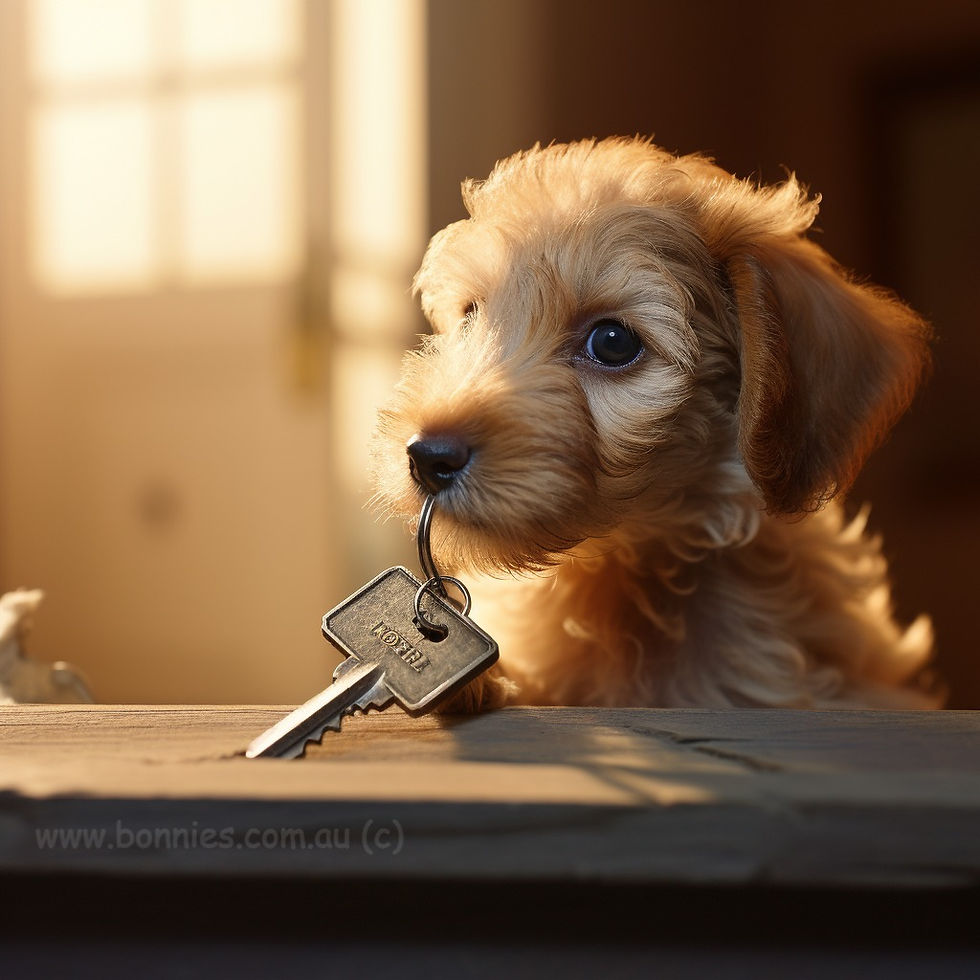
THIS IS THE KEY: The leash is not a weapon of mass frustration. Soft hands and a calm disposition creates a great team. Starting this very early in a puppies life is "Setting your dog up for success". We know, that in the not too distant future, they will be on a leash.Your puppy will become very accustomed to it when you start as early as possible. Your puppy will be walking around, exploring the lounge, and the leash will trail behind them. No stress. REMINDER: The amount of time a new puppy has a leash on in the first week or 2 is only a very short time. T It's better to practice something more often in a day, than try to have it on too long. Process and procedure, canines love rules and direction but most of all consistency.
Puppy age 8 week thru 10, start at 30 seconds at a time but up to 4 times in a day Total 2 minutes a day - really whenever you have a few minutes to share with your puppy.
Puppy age week 10-12, Up to 5 minutes at a time, after which you will see that the puppy is very comfortable and you can extend the time as you wish.
What do I do if my puppy is naughty?
I will always say to our "Bonnies" clients that a puppy is not really Naughty. We just haven't trained them yet. If the puppy starts to grab it, chew on it etc, take it off without making a fuss. Don't yell at them. Offer them a toy, so they drop the leash and then you can remove it. NEVER pull the leash out of your puppies mouth as this can seriously injure your puppies teeth.
You can also utilise this trailing leash, as a tool for curbing unwanted behaviors, like jumping up on children or other pets. A simple foot on the lead, can, effectively communicate limits and give the puppy a chance to become calm and relaxed. We call this little exercise "the worlds hardest training exercise for humans". It's an OFF Button for your puppy as it is important to know. However, exercise extreme caution when you put your foot on the leash, while your puppy is running, as abrupt stops can unintentionally harm them, causing neck strain and other injuries. Please put the leash on the puppy when they are calm and chilled. They may even be about to go to sleep or lie down. Put on the leash and give them a calm pat and some love.
PICK the time when the puppy is CALM. RULE # 1
As I have already suggested, please don't leave the house leash on when your puppy is crated, or in a playpen, or outside in the yard running around. Instead, reserve its use for when they're with you - inside the home, where possible for the first 2 - 4 weeks, in the lounge room, or where ever you may be chilling out. Once they are comfortable you can then use this in the yard.
What are the Benefits of Leash Training?
Starting leash training early on is a game-changer for your puppy's development. By introducing a house lead and ensuring supervised training to familiarise your puppy, you pave the way for a confident, well-mannered mate. Remember, a few small steps now can lead to a lifetime of harmonious walks and interactions.
Many people and families miss this important "Imprint Period" or learning opportunity for our puppy. Often they either don't realise it's vital importance or are led to believe a puppy should not use one till they are older. Puppies grow really accustomed to the collar and leash when introduced early, leading to lifelong comfort and understanding. Some believe a leash is only for walks, but its value extends far beyond that. Familiarity with the collar and leash aids relaxation, so when your puppy ventures out into the world, they begin their walking life in as relaxed state as possible. Calm. The overall benefits of leash training should not be underestimated. They are extensive and Lifelong.
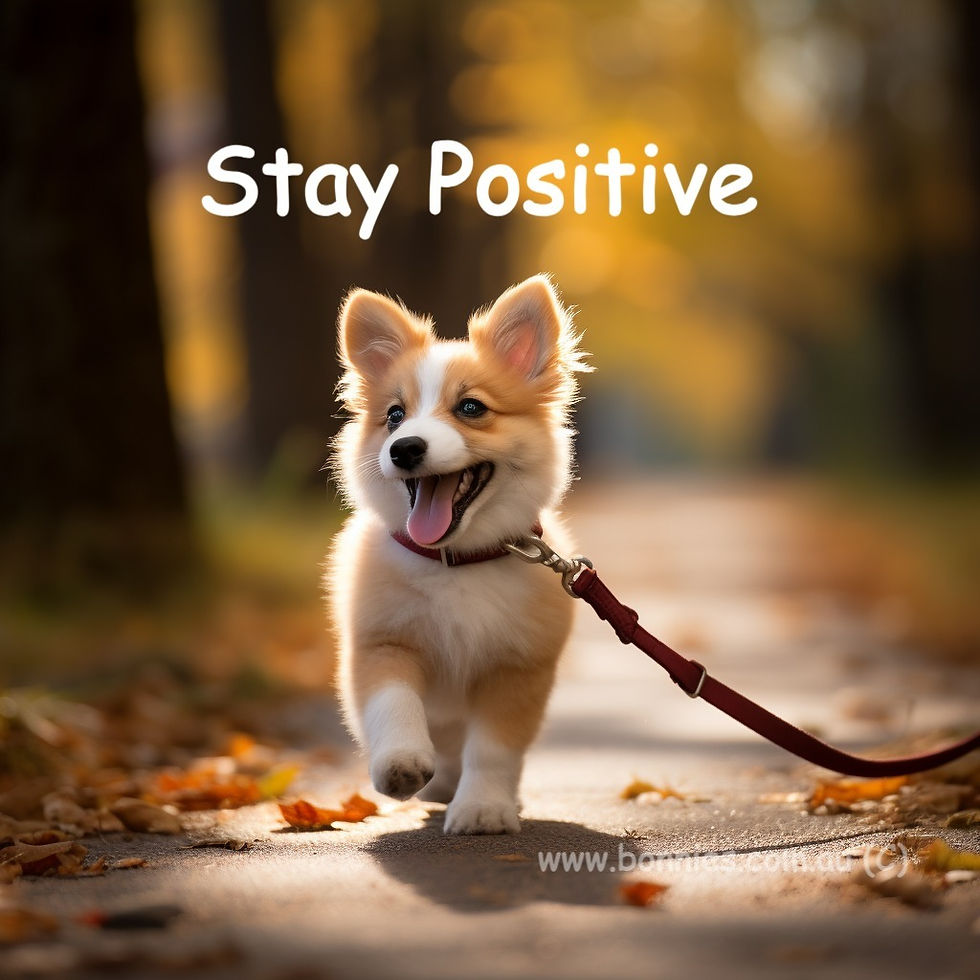
What is, 'Creating Positive Canine Associations'?
For young puppies, the leash can initially be an unfamiliar and even very misunderstood object. Any Juvenile or dog will have a greater or lesser resistance to a collar and, or a leash, if they are not familiarised correctly with them early on in life. To create positive associations, follow these easy steps:
How do you introduce leash training?
Introduction Phase: Allow the puppy to investigate the leash in a non-threatening environment. Let them see it and smell it. We call this "Show and Tell" and we offer the puppy treats and praise, to associate the leash with positive experiences. Be POSITIVE and use great TONE and PITCH to mark the puppies success. Not too loudly and with real vigor - calming and lovely would be great. Done really well and over a correct period of time, this does make a difference. Familiarise with many items around the house, and around the puppies immediate areas, such as Mowers, blowers, hair dryers, brooms etc etc all need to be. "Show and Tell" up to a dozen times before they are relaxed with it.
Collar Introduction: Gradually introduce the collar soon after getting the puppy. Most breeders will have a collar on the dog when you pick it up. It may not fit for too long so consistently check the fit. Read the article on Collars. Rewarding the puppy for wearing it helps them get used to the sensation around their neck.
Leash Attachment: Once the collar is comfortable on the puppy, attach a lightweight leash and let the puppy drag it around under supervision. This helps them acclimate to the weight and feel of the leash. Do NOT let them chew or play with the leash. A very gentle correction again using tone and pitch and use the Command - Leave or Leave It and the stop sign - hand signal. Then look away. This should be enough for them to stop. Please don't make this into a game. The Leash and The Collar is NEVER a game. I say this to the clients "When you attach a lead to a collar for the first time - its only for 30 seconds - then, Take it off and the puppy gets a reward. The puppy must associate the Leash with a treat and or reward - BE Positive.
How do you teach leash skills?
Using a leash correctly is essential for effective training and preventing harm to your puppy. Here are some important techniques and skills to follow:
BE RELAXED: Maintaining a relaxed demeanor during training is essential for achieving optimal results. For me, there is simply no question about it. I suggest that when you're not in the best frame of mind, and in order to ensure the best outcomes for your puppy, don't train. You can of course interact and engage as mates. When our mate is helping us, when we are anxious, by sitting with us then that is all we need. The training comes when you are free to teach and instruct your best mate.
A CANINE will pick up your energy, scent your feelings and react accordingly. Always remember that your puppy is your best friend, so approach training with a calm attitude. Calm handler - Calm Puppy. Prevent any frustration we all feel from time to time, from making the experience anything but positive. Consistently finish each and every training session or even a single task, like a sit command, with a positive interaction. Whether it's a treat, a gentle pat, or affection, these gestures resonate well. This along with great Pitch and Tone in our voice, cultivates a positive association and primes your puppy for further practice sessions later in the day. Although corrections might be necessary on occasion, they should be conducted calmly, devoid of loudness, obnoxiousness, harm, or disrespect.
Your role as an Alpha figure necessitates composure and a relaxed demeanor, qualities that resonate with your puppy. To correct a behaviour, often we can simply change the focus of the puppy, onto something else - then come back to the exercise. Correction is NOT yelling at them. Read about the 'LEAVE IT" command.
Positive Reinforcement: Always keep training positive. Reward your puppy with treats, praise, and gentle petting when they walk beside you on the leash without pulling. Take your time and never be in a hurry to go anywhere. Getting them comfortable and calm is your only goal for the first 4 weeks of having them at home. After at least 4 weeks of this ONLY then should we expect them to be walking on the leash without pulling. Most of the time.
Start in a Controlled Environment: Begin your training sessions in a quiet, familiar area with minimal additional distractions. As your puppy becomes more comfortable, gradually introduce them to busier environments. I will suggest using a house leash for the first week or 2. Then connect a standard leash and start having a walk inside the house. then after another 1 week I suggest the walking and training can be done outside in the yard. This is ALL well before you take them out for a walk on the street. (Vaccinations Considered)
What should my leash be made from?
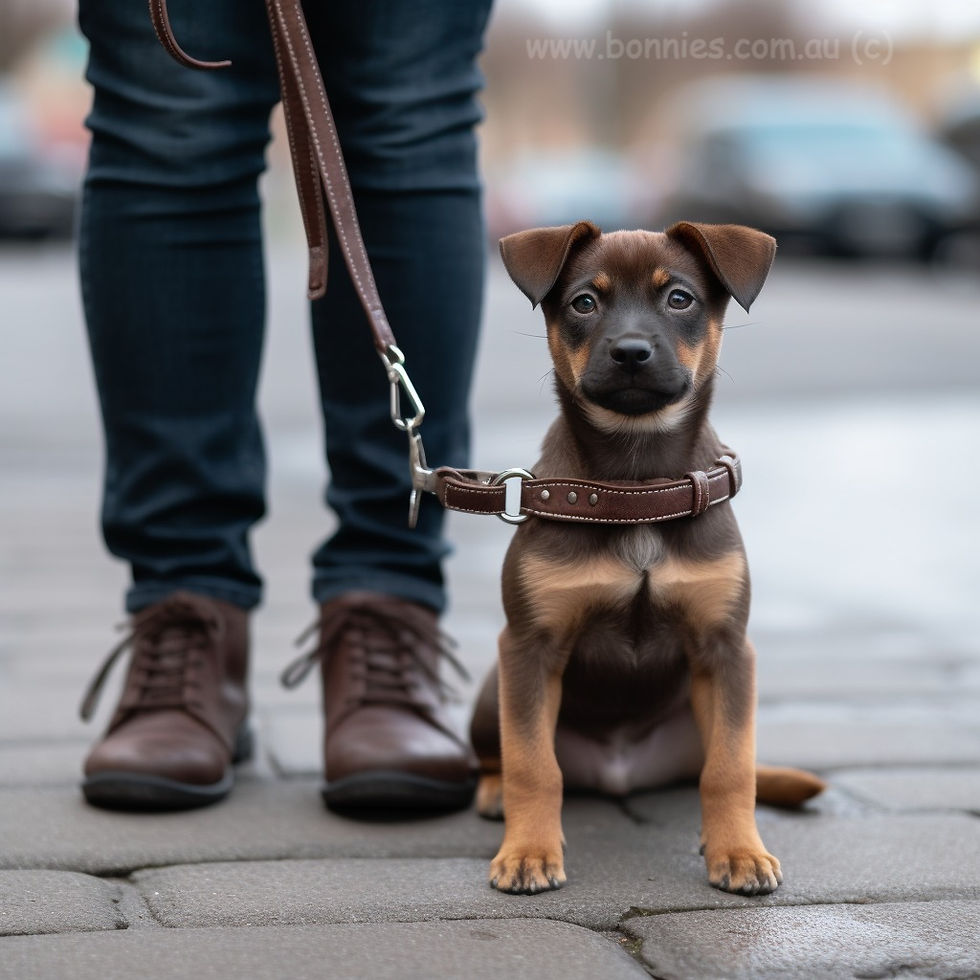
Opt for a lightweight, nylon or leather leash (Leather is great) and I general recommend them for mid - larger breeds. The length of about 1.5 mtr thru to 2.5 mtr is suitable. You can choose round, flat, stretch or other flavour of the day leash at Pet Barn or other big box store. We use FLAT leads because they are perfect for managing a puppy when we put our foot on it. It won't slip or roll under your foot. I also know first hand that you need a material which won't burn or mark your hand, if the dog suddenly pulls. I never suggest chain or metal leash's as they are brutal on the hands. Great if you want to tether the dog. I don't use them to tether a puppy as they can break the puppies teeth, if they get frustrated and chew on the metal links.
What is the best width of a leash?
Flat leash's can be from 1/2 inch = 12 mm up to around 1 inch = 2.5 cms in width. Even long leash or lunge leads can be the same width. The length can be up to around 10 meters but these are specifically for Training, Beach walks and other areas where the puppy can play and run. In many jurisdictions you can NOT use them legally as they suggest the dog is NOT under your control.
Can I use a retractable Leash /Lead?
Lack of Genuine Control: Steering clear of retractable leashes is advisable, given that they can compromise your ability to maintain true control over your puppy's movements, both up close and when extended. These leashes, while providing freedom, can hinder your training efforts by limiting your influence on your puppy's behavior during training sessions.
Recommended for Training: I encourage our clients to opt for alternative leash options rather than turning up for training sessions with extender or retractable leashes. We always have one available for them to borrow. The rationale behind this recommendation is grounded in the essential need for effective control during training sessions. These leashes often hinder my clients ability to employ proper training techniques, impacting the learning experience for both them and their puppy.
Limited Socialisation and Safety Concerns: Three distinct reasons underscore the caution against using extensible leashes. Firstly, these leashes may restrict your genuine control over your puppy, making them unsuitable for practical training endeavors. Secondly, the socialisation process and overall leash management are essential aspects of puppy training, and this is because most people are focused on the leash, and trying to get it to retract, thus they are watching the wrong thing. Thirdly the complexity of extensible leashes can lead to entanglements, putting both puppies and their handlers at risk. The real possibility of leashes becoming intertwined can even escalate to aggression between otherwise calm puppies. This scenario takes away their natural instinct to flee and may prompt a fight response. In the event of such an occurrence, it's crucial to remain composed and avoid panicking, as overexcitement may amplify the situation. Instead, maintaining a calm tone and demeanor can help defuse tension and restore a sense of control. In order to be able to read your puppies body language then it is important to decode your dogs body language.
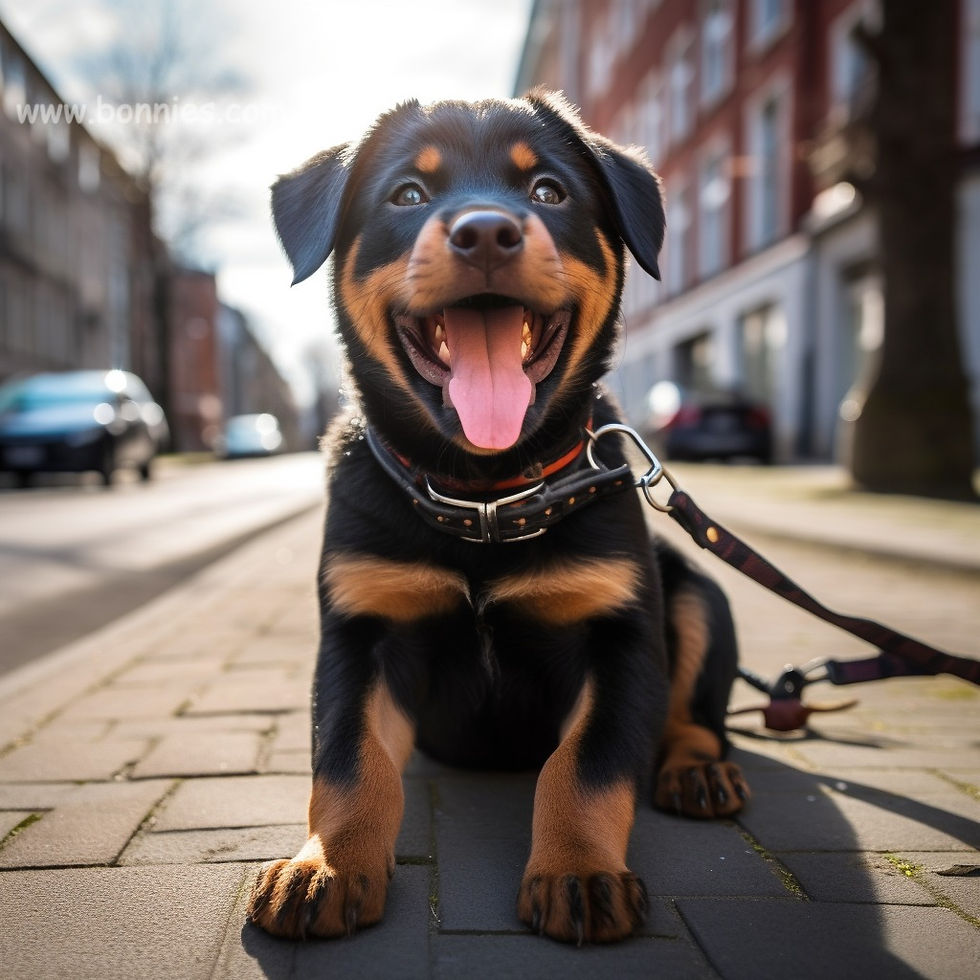
What Training Sessions should I include with Leash Training?
For both puppies and older pups, follow these steps however you will need a Puppy Training Blueprint.
How often should I practice loose leash training?
When beginning leash training, it's essential to structure your sessions effectively. To maintain your puppy's focus and avoid frustration, opt for brief training sessions lasting around 5 minutes, which can be repeated 3 to 4 times throughout the day. Avoid overtraining, as it can lead to burnout. Start the training process indoors or on your deck or verandah, creating a controlled environment. This is particularly important for 8-week-old puppies, as they can absorb most of their leash-related skills within the confines of your home. Surprisingly, more than 80% of puppy owners neglect using a leash indoors. However, this practice inadvertently hampers their progress. Why is this problematic? Imagine if the only time your puppy encounters a leash is during high excitement walks. The leash and collar directly link us to our puppies, making early and consistent training crucial. By doing so, you effectively "set them up for success" (The Bonnies Mantra) in their overall training journey.
ALL TRAINING should start in the house. Then to train in the backyard or in the courtyard, and ONLY after training our puppy in these areas, should we take our puppy out for walks etc. Within the timings of this you can still take your puppy to puppy school. We hope you will choose our School if your in Brisbane.
What is a loose leash?
Loose leash, does not mean Long Leash. Loose leads / leash specifically refers to the slackness of the leash from your left hand, which is down by your side, down to the collar of the dog. This must always be slack. In order to get this right I get the clients to have the leash on the puppy and then hold the lash firm. Then i get them to add about 1 - 2 feet = 30 cms - 50 cms. Thats the hold point on the leash. Now the puppy is not being held in place. Holding a dog in place ios not going to work as a training method. A long loose leash is where the dog and puppy simply goes out to the maximum length of the leash plus your arm length. So now they may be 3 or more metres away. In reality training this way can make it difficult in the future to keep them by your side as you may be inadvertently teaching them thats its ok to be that far away from you.
How do I practice my loose leash walking?
One of the key skills in leash training for puppies is achieving loose leash walking, a practice that encourages your puppy to walk comfortably beside you without tension on the leash. This skill requires patience and a nurturing approach. When engaging in loose leash walking, it's important to remember that pulling is a common behavior, especially in the initial stages, and it's completely normal for your puppy to stop moving at times. When you are having a little walk around the house - engage your puppy with your voice - tone and pitch and a treat in your hand to GUIDE the puppy along the hallway. NO PRESSURE on the leash at all.
Gentle Guidance, No Pulling: When your puppy pulls on the leash, it's essential to refrain from pulling them back. AT Bonnies "We set your dog up for success - Not failure". The object of everything you do with your puppy is to become partners in life and for life. They don't need or want any one pushing and pulling them. It can't work. Instead, when you feel the tension on the leash, stop walking and wait until the leash becomes slack again. Talk to your puppy - engage and be "Fun to be around". the "Life of the Party". Yes this exercise can be fun. Use your wonderful treats too.
Should I use Vocal Cues and Visual cues?
In the beginning, your puppy might resist the idea of walking without pulling, and that's perfectly okay. It's not unusual at all for the puppy to just SIT and not move at all. Utilise your tone and pitch to convey encouragement. Your puppy's name, combined with an inviting tone, can work wonders. If they need an extra incentive, promise them a treat to keep them engaged and motivated. For instance, let's say your puppy's name is Max. When Max starts to slow down or stop, gently use his name followed by a cheerful "Come!" This combination often sparks their curiosity and prompts them to move again. Be patient during this process; some puppies might take a little time to understand the routine.
The Art of Relaxation: Maintaining a relaxed and calm demeanor is crucial when guiding your puppy in practicing your loose leash walking in the house and yard. Keep the leash length appropriate for your environment, whether it's short or long. However, the key factor is the space between your left hand and the collar. (This assumes that the puppy is walking on your left hand side). This space - Collar to Left Hand should always be loose and comfortable, ensuring there's no pressure on the leash. Remember, the goal is to create a positive association with walking beside you without tension. Tugging and pulling on the leash can lead to frustration for both you and your pup, so focusing on relaxation and gentle guidance is paramount.
Building a Lifelong Skill: Loose leash walking isn't an overnight achievement; it's a gradual process that requires consistency and understanding. Embrace each walk as a learning opportunity for your puppy. As they become more accustomed to the routine, you'll notice improvements in their leash manners.
Mastering loose leash walking is about creating a comfortable and enjoyable experience for your puppy. By using encouraging vocal cues, being patient, and prioritising relaxation, you'll help your pup develop a valuable skill that will serve them well throughout their life.
Does changing direction with my puppy work?
Change directions reasonably frequently to keep your puppy engaged and attentive to your movements. I also get the clients to Turn Left with their puppy. Most of the time people with puppies turn away from the side the dog is on. The reason this happens is that it is easier. If you turn left, you are turning across the dog, and therefore the puppy MUST drop back to your side so you can turn left. This is a great exercise as it really trains the puppy to be aware of where you are and to focus on you.
Why does my puppy sit down and not walk when they are on a leash?
There could be several reasons why your puppy stops and refuses to move while you're walking it, particularly when you are just starting to use the leash. So here are 9 reasons why they might. Have you ever seen a Donkey who sits on the road and locks their front feet.
Here are 9 reasons why your puppy may sit when your leash training!

Curiosity: Sometimes it might kill the cat, woof. Puppies are naturally curious animals, and they might stop to investigate a new scent, object, or sound. Their senses are heightened too as they are out and about, and they might want to look at something that caught their attention.
Fear and or Anxiety: If your puppy encounters something that frightens or makes it anxious, it might stop dead in its tracks. This could be a loud noise, a sudden movement, or an unfamiliar environment and can even be something like a car horn or even a loud bird.
Overstimulation: Puppies, especially young ones, can become overstimulated easily. If there's a lot of activity, noise, or unfamiliar people or animals around, your puppy might become overwhelmed and stop moving as a way to cope. I am confident in suggesting that this is often one of the main reason for a puppy stopping. This happens a lot when there are young kids around too.
Tiredness: Most puppies sleep 16 - 18 hours a day. Puppies have bursts of energy, but they can tire out quickly, especially during the early stages of their development. If your puppy has been playing or walking for a while, it might simply need a break and refuse to move further. When we really know our dog we can appreciate that they have: EG been awake and playing with the kids or been running around. When this happens they may drop like a stone. Out, like the proverbial light. On the spot. Do not push at all when this happens. Pick them up, give them some love and a hug, and take them home.
Medical Issues: Sometimes, a puppy might stop moving due to pain or discomfort. Check for any signs of limping, favoring a leg, or changes in behavior that might indicate a health issue. Sometimes medical issues do not have anything that you can put your finger on. If your puppy is lethargic, vomiting or any other issue. Take them to the vet immediately.
Training and Socialisation: As I have mentioned earlier, if your puppy is young and still in the process of learning how to walk on a leash, it might be resisting the leash because it's not accustomed to it. Proper leash training and positive reinforcement can help overcome this. Tone and Pitch. This is the reason that we leash train early.
Lack of Motivation: Can Puppies be stubborn? Yes they sure can be and if they don't see a reason to move, they might decide to stop. Using treats, toys, or other rewards can help motivate them to keep walking. Once again Tone and Pitch will be very helpful.
Attention-Seeking: Puppies might quickly learn that stopping gets them attention. If you react every time your puppy stops, it may very well start using this behavior to get your focus on them. Who is teaching who now? Take some time and further investigate why your puppy needs to know and respond to their name.
Attention-Seeking: Sometimes I think they can just be stubborn just like a little kid. Oh well someone has to be the adult in the relationship, right.
Transitioning to Older Puppies: For older puppies, the focus shifts toward refined leash manners. Continue building on the positive associations established during the early stages and progressively work on more advanced skills, such as heeling, sitting at intersections, and staying calm around distractions. It also matters if the puppy is a rescue and they have not been familiarised correctly or indeed at all.
Should my dog have any FREE time when they are on a leash?
YES. Absolutely and definitely. When we start to walk our puppy, now into their juvenile months, that they have some free time whilst on a walk. I suggest to our clients that the puppy be walking right beside your dominant hand. In Brisbane and Australia we walk our dogs on the left hand side so the dominant hand is the Left hand in this case. So on a walk they need to be beside you and your job is to keep the puppies attention on you. Walk about 100 meters then Stop. Tell your dog - FREE. Then let them scent and go to the toilet and pick up a stick and just be a dog. When you are ready, bring them back to your left, with a quick - COME. Then repeat the process. Have fun, be an alpha, be cool and relaxed and be a Best Mate for your dog.
Conclusion: Leash training is an ongoing process that requires patience, consistency, and a positive attitude. By starting early and using the correct techniques, you can help your puppy or older pup develop excellent leash manners and become a well-behaved and confident companion. Remember that every dog is unique, so tailor your training approach to suit your pup's personality and needs. With dedication and guidance, you can enjoy many pleasant walks together, building a strong bond along the way.

Unlock the Path to Successful Dog Training Today! Share this knowledge with your fellow dog and puppy owners and lovers, as knowledge empowers us all. Skip the search for generic terms like 'dog training Brisbane' or 'dog training near me.' Instead, head over to bonnies.com.au for expert insights and tailored solutions. Delve into our range of informative articles for further enrichment. We highly value your input, so please drop a comment if you have suggestions or topics you'd like us to cover. For a wealth of wisdom, explore Val's Books Seize the chance to elevate your dog training journey – take the plunge now and unleash your four-legged companion's full potential! Best regards, Peter Bonney.





Super article. Well informed and easy to read.
Loved reading this. Thank you.